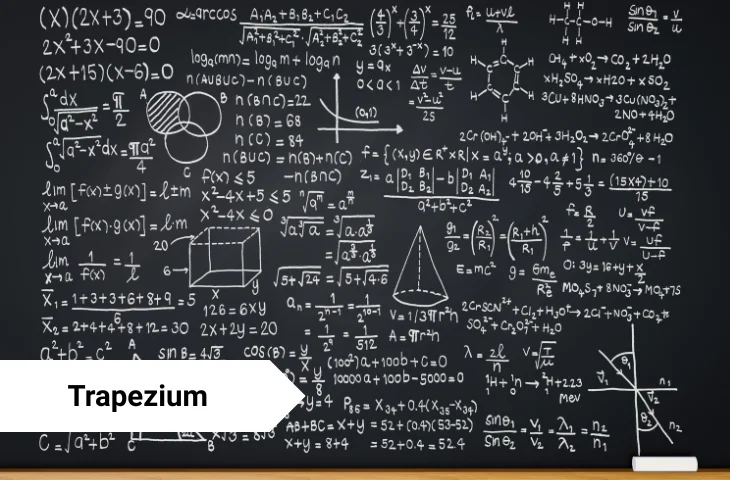The Trapezium is a quadrilateral with exactly one pair of parallel sides. It is a frequently tested geometry topic in SSC, Banking, and Railway exams. In this blog we have provided all the details from the definition, key properties, formulas, tricks, solved questions, and more.
What Is Trapezium in Quantitative Aptitude?
Let’s begin by understanding the basic definition and properties of a trapezium and why it is an important topic in quantitative aptitude exams.
A Trapezium (or trapezoid) is a quadrilateral where only one pair of opposite sides are parallel. The parallel sides are called the bases, and the other two are the legs.
Why it appears in exams:
- Tests knowledge of quadrilaterals and mensuration formulas.
- Requires application of area and perimeter formulas with height and bases.
Skills required:
- Understanding parallel sides and height
- Application of area formula
- Visualization of shape properties
Why Is Trapezium Important in Competitive Exams?
Trapezium questions appear regularly in competitive exams due to their moderate difficulty and applicability in mensuration problems.
| Exam | No. of Questions | Difficulty |
| SSC CGL / CHSL | 1–2 | Moderate |
| IBPS PO / SBI PO | 1–2 | Moderate |
| RRB NTPC / Group D | 1 | Easy |
| State PSC / Police | 1–2 | Moderate |
Trapezium Quantitative Aptitude Short Notes
This section summarizes the key concepts and terminology related to trapeziums in a concise table for quick reference.
| Term | Details |
| Parallel sides (bases) | Only one pair of parallel sides |
| Legs | Non-parallel sides |
| Height (h) | Perpendicular distance between parallel sides |
| Interior angles | Sum is always 360° |
| Area | 12×(a+b)×h\frac{1}{2} \times (a + b) \times h21×(a+b)×h |
| Perimeter | Sum of all four sides |
Quick Revision Summary
Here’s a quick summary of the essential formulas and facts about trapeziums.
| Concept | Explanation |
| Number of parallel sides | Exactly one pair |
| Bases | Parallel sides |
| Height | Perpendicular distance between bases |
| Area formula | 12×(a+b)×h\frac{1}{2} \times (a + b) \times h21×(a+b)×h |
| Perimeter formula | Sum of all sides |
| Sum of interior angles | 360° |
What Are the Types of Trapezium Questions in Quantitative Aptitude?
Trapezium problems can appear in various forms in exams. Understanding the common question types will help you prepare effectively.
- Direct formula application: Find area or perimeter given bases and height.
- Missing side problems: Calculate missing leg using perimeter or Pythagoras theorem (if right trapezium).
- Mixed problems: Combined with other mensuration topics or coordinate geometry.
- Angle-based problems: Using properties of trapezium angles.
Trapezium Formulas for Quantitative Aptitude
In this section, we list all the important formulas related to trapeziums that will help you solve problems faster.

Trapezium Tricks for SSC CGL and Other Exams
These quick tips will help you solve trapezium questions more efficiently in competitive exams.
- Always identify which sides are parallel to correctly apply the area formula.
- Use the Pythagoras theorem for right trapezium to find missing sides or height.
- Remember the sum of interior angles is 360°, helpful in angle-based problems.
- Convert complex trapeziums into simpler shapes if possible.
- Check units carefully when calculating area and perimeter.
Solved Trapezium Questions from 2024–25 Exams

Common Mistakes to Avoid while Solving Trapezium Questions
Avoid these common mistakes to score better in trapezium questions:
- Mixing up legs and bases for area calculation.
- Forgetting to use the perpendicular height, not the slant height.
- Incorrectly assuming non-parallel sides are equal.
- Ignoring units during calculation.
- Confusing trapezium with parallelogram.
FAQs
The perpendicular distance between the parallel sides.
No, because a parallelogram has two pairs of parallel sides.
Some trapeziums can be cyclic if the sum of opposite angles is 180°.
Depends on country usage; often used interchangeably.
Yes, often in mensuration or DI.
- MP Apex Bank Vacancy, 2076 Clerk and Officer Posts for 2026 Cycle
- MP Cooperative Bank Recruitment 2026, Apply for 2076 Posts
- MP Apex Bank Syllabus 2026 and Exam Pattern for Clerk and Officer Posts
- SSC CGL Typing Test Error 2025, Full Mistake, Half Mistake
- SSC GD Post Code, Meaning, List, and Selection Process Explained
- SSC GD Total Form Fill Up 2026, Applications, Trend & Competition Ratio

Hi, I’m Aditi. I work as a Content Writer at Oliveboard, where I have been simplifying exam-related content for the past 4 years. I create clear and easy-to-understand guides for JAIIB, CAIIB, and UGC exams. My work includes breaking down notifications, admit cards, and exam updates, as well as preparing study plans and subject-wise strategies.
My goal is to support working professionals in managing their exam preparation alongside a full-time job and to help them achieve career growth.
